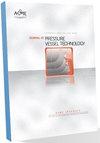Damage Model Prediction of Crack Initiation and Propagation in Five Fracture Geometries for X80 Pipeline Steel
IF 1
4区 工程技术
Q4 ENGINEERING, MECHANICAL
Journal of Pressure Vessel Technology-Transactions of the Asme
Pub Date : 2022-02-02
DOI:10.1115/1.4053737
引用次数: 2
Abstract
Test specimens used to calibrate damage-mechanics models are designed to produce a range of stress triaxialities and Lode angles to accurately capture the fracture envelope of the metal. Many of these specimens have lower constraint than deeply-notched fracture specimens that undergo stable tearing and have high constraint at the crack tip. Often just one or two fracture geometries are used to calibrate the model. In the current work, the ability of a damage model to capture variability associated with constraint at a crack tip, particularly for crack initiation, is assessed. A recent round-robin [1] study on the initiation toughness of X80 provided data for five fracture specimens in which crack tip constraint varied. As a damage model for X80 was not available, the well-calibrated MMC damage models from literature for X65 and X70 were used as a starting point for the model. Experimental data from the single Compact Tension C(T) specimen was used to slightly modify the X65 and X70 models to capture the X80 fracture response. The MMC damage model was applied in FEA to simulate both the crack initiation and propagation responses of Single-Edge-Notched-Tension (SENT) and surface-cracked pipe specimens. Except for a low J-integral at initiation predicted for the C(T) specimen, the remaining predicted responses for force, pressure, and initiation were in good agreement with the experimental data provided in the round-robin.X80管线钢五种断裂形态裂纹萌生和扩展的损伤模型预测
用于校准损伤力学模型的试样设计用于产生一系列应力三轴和Lode角,以准确捕捉金属的断裂包络。这些试样中的许多比经历稳定撕裂并在裂纹尖端具有高约束的深缺口断裂试样具有更低的约束。通常只使用一个或两个断裂几何形状来校准模型。在目前的工作中,评估了损伤模型捕捉与裂纹尖端约束相关的可变性的能力,特别是对于裂纹萌生。最近一项关于X80起始韧性的循环研究[1]提供了五个裂纹尖端约束变化的断裂试样的数据。由于X80的损伤模型不可用,因此使用X65和X70文献中校准良好的MMC损伤模型作为模型的起点。来自单个紧凑张力C(T)试样的实验数据用于略微修改X65和X70模型,以捕捉X80断裂响应。将MMC损伤模型应用于有限元分析中,模拟了单边缘缺口拉伸(SENT)和表面裂纹管道试样的裂纹萌生和扩展响应。除了C(T)试样在初始时预测的低J积分外,其余预测的力、压力和初始响应与循环中提供的实验数据非常一致。
本文章由计算机程序翻译,如有差异,请以英文原文为准。
求助全文
约1分钟内获得全文
求助全文
来源期刊
CiteScore
2.10
自引率
10.00%
发文量
77
审稿时长
4.2 months
期刊介绍:
The Journal of Pressure Vessel Technology is the premier publication for the highest-quality research and interpretive reports on the design, analysis, materials, fabrication, construction, inspection, operation, and failure prevention of pressure vessels, piping, pipelines, power and heating boilers, heat exchangers, reaction vessels, pumps, valves, and other pressure and temperature-bearing components, as well as the nondestructive evaluation of critical components in mechanical engineering applications. Not only does the Journal cover all topics dealing with the design and analysis of pressure vessels, piping, and components, but it also contains discussions of their related codes and standards.
Applicable pressure technology areas of interest include: Dynamic and seismic analysis; Equipment qualification; Fabrication; Welding processes and integrity; Operation of vessels and piping; Fatigue and fracture prediction; Finite and boundary element methods; Fluid-structure interaction; High pressure engineering; Elevated temperature analysis and design; Inelastic analysis; Life extension; Lifeline earthquake engineering; PVP materials and their property databases; NDE; safety and reliability; Verification and qualification of software.

 求助内容:
求助内容: 应助结果提醒方式:
应助结果提醒方式:


